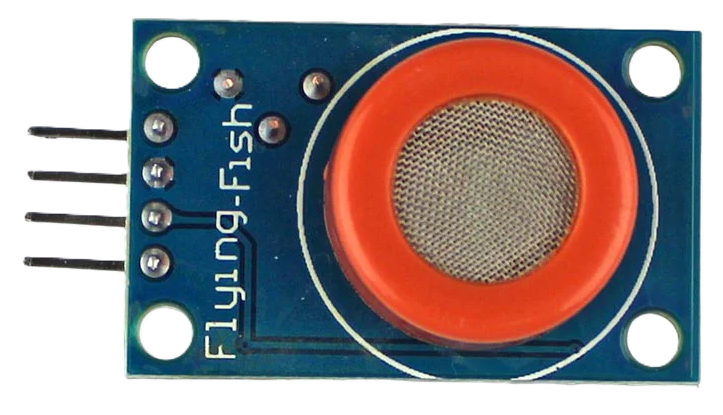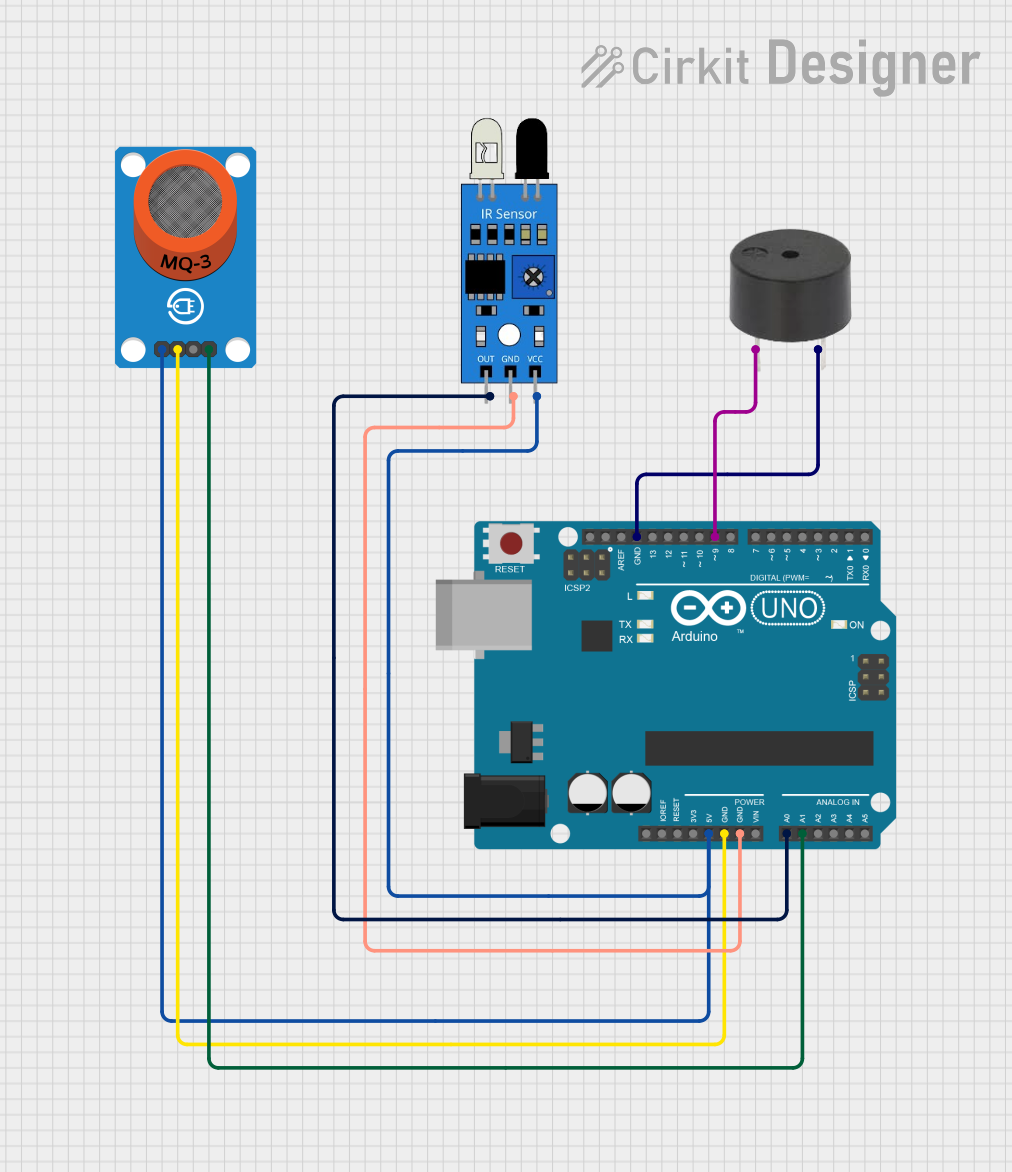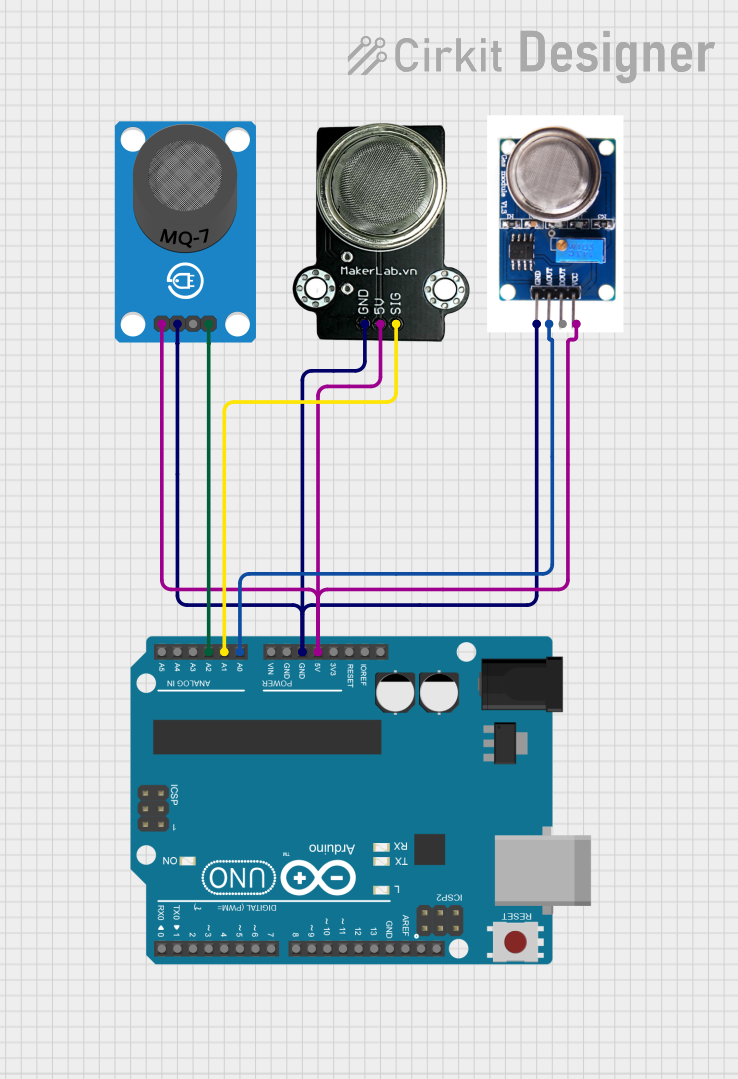
How to Use MQ-3: Examples, Pinouts, and Specs

 Design with MQ-3 in Cirkit Designer
Design with MQ-3 in Cirkit DesignerIntroduction
The MQ-3 is a gas sensor designed to detect alcohol vapors in the air. Manufactured by Flying Fish, this sensor operates on the principle of resistive change when exposed to specific gases. It provides an analog output proportional to the concentration of alcohol vapors, making it ideal for applications requiring alcohol detection.
Explore Projects Built with MQ-3

 Open Project in Cirkit Designer
Open Project in Cirkit Designer
 Open Project in Cirkit Designer
Open Project in Cirkit Designer
 Open Project in Cirkit Designer
Open Project in Cirkit Designer
 Open Project in Cirkit Designer
Open Project in Cirkit DesignerExplore Projects Built with MQ-3

 Open Project in Cirkit Designer
Open Project in Cirkit Designer
 Open Project in Cirkit Designer
Open Project in Cirkit Designer
 Open Project in Cirkit Designer
Open Project in Cirkit Designer
 Open Project in Cirkit Designer
Open Project in Cirkit DesignerCommon Applications and Use Cases
- Breath analyzers for alcohol detection
- Gas leak detection systems
- Industrial safety equipment
- Home automation systems for air quality monitoring
- Embedded systems and IoT projects
Technical Specifications
The MQ-3 sensor is a versatile and reliable component with the following key specifications:
| Parameter | Value |
|---|---|
| Operating Voltage | 5V DC |
| Load Resistance (RL) | 200Ω to 10kΩ |
| Heater Voltage (VH) | 5V ± 0.2V AC/DC |
| Heater Power Consumption | ≤ 800mW |
| Detectable Gas | Alcohol vapors |
| Detection Range | 0.04 mg/L to 4 mg/L (alcohol) |
| Preheat Time | ≥ 24 hours for optimal accuracy |
| Output Signal | Analog voltage (proportional to gas concentration) |
Pin Configuration and Descriptions
The MQ-3 sensor module typically has four pins. Below is the pinout description:
| Pin | Name | Description |
|---|---|---|
| 1 | VCC | Power supply pin. Connect to 5V DC. |
| 2 | GND | Ground pin. Connect to the ground of the circuit. |
| 3 | AOUT | Analog output pin. Provides a voltage proportional to the alcohol concentration. |
| 4 | DOUT | Digital output pin. Outputs HIGH or LOW based on a preset threshold. |
Usage Instructions
How to Use the MQ-3 in a Circuit
- Power the Sensor: Connect the VCC pin to a 5V DC power source and the GND pin to the ground.
- Connect the Output:
- Use the AOUT pin for analog readings to measure alcohol concentration.
- Use the DOUT pin for digital readings if a threshold comparator is configured.
- Preheat the Sensor: Allow the sensor to preheat for at least 24 hours for optimal accuracy.
- Read the Output:
- For analog readings, connect the AOUT pin to an ADC (Analog-to-Digital Converter) pin of a microcontroller.
- For digital readings, connect the DOUT pin to a digital input pin of a microcontroller.
Important Considerations and Best Practices
- Preheating: The sensor requires a preheating period of at least 24 hours for stable and accurate readings.
- Calibration: Calibrate the sensor in a controlled environment to ensure accurate detection of alcohol concentration.
- Ventilation: Ensure proper ventilation around the sensor to avoid saturation and improve response time.
- Avoid Contamination: Keep the sensor away from water, oil, and other contaminants that may affect its performance.
- Load Resistor: Select an appropriate load resistor (RL) based on the desired sensitivity and application.
Example: Using MQ-3 with Arduino UNO
Below is an example of how to connect and use the MQ-3 sensor with an Arduino UNO to read analog values:
// MQ-3 Alcohol Sensor Example with Arduino UNO
// Connect the AOUT pin of the MQ-3 to the A0 pin of the Arduino UNO
// Connect VCC to 5V and GND to ground
const int analogPin = A0; // Pin connected to the AOUT of MQ-3
int sensorValue = 0; // Variable to store the analog reading
void setup() {
Serial.begin(9600); // Initialize serial communication at 9600 baud
Serial.println("MQ-3 Alcohol Sensor Test");
}
void loop() {
sensorValue = analogRead(analogPin); // Read the analog value from MQ-3
Serial.print("Sensor Value: ");
Serial.println(sensorValue); // Print the sensor value to the Serial Monitor
delay(1000); // Wait for 1 second before the next reading
}
Notes:
- The analog value (
sensorValue) can be mapped to a specific alcohol concentration using calibration data. - Use a voltage divider circuit if the output voltage exceeds the ADC input range of the microcontroller.
Troubleshooting and FAQs
Common Issues and Solutions
No Output or Incorrect Readings:
- Ensure the sensor is properly powered (5V DC).
- Verify the connections to the microcontroller.
- Allow sufficient preheating time (≥ 24 hours).
Unstable or Fluctuating Readings:
- Check for proper ventilation around the sensor.
- Ensure the load resistor (RL) is within the recommended range (200Ω to 10kΩ).
- Avoid placing the sensor in a high-humidity environment.
Sensor Not Responding to Alcohol Vapors:
- Confirm that the alcohol concentration is within the detectable range (0.04 mg/L to 4 mg/L).
- Check for contamination or damage to the sensor.
FAQs
Q1: Can the MQ-3 detect gases other than alcohol?
A1: While the MQ-3 is optimized for alcohol detection, it may respond to other gases with similar properties. However, its sensitivity and accuracy for non-alcohol gases are not guaranteed.
Q2: How long does the MQ-3 sensor last?
A2: The sensor has a typical lifespan of 2-3 years under normal operating conditions. Proper maintenance and avoiding contamination can extend its life.
Q3: Can I use the MQ-3 without preheating?
A3: Preheating is essential for accurate readings. Without preheating, the sensor may provide unstable or incorrect outputs.
Q4: How do I calibrate the MQ-3 sensor?
A4: Calibration involves exposing the sensor to a known concentration of alcohol vapor and recording the corresponding output voltage. Use this data to map the sensor's output to alcohol concentration in your application.
Q5: Is the MQ-3 suitable for portable devices?
A5: Yes, the MQ-3 can be used in portable devices, but ensure the power supply and ventilation are adequate for proper operation.